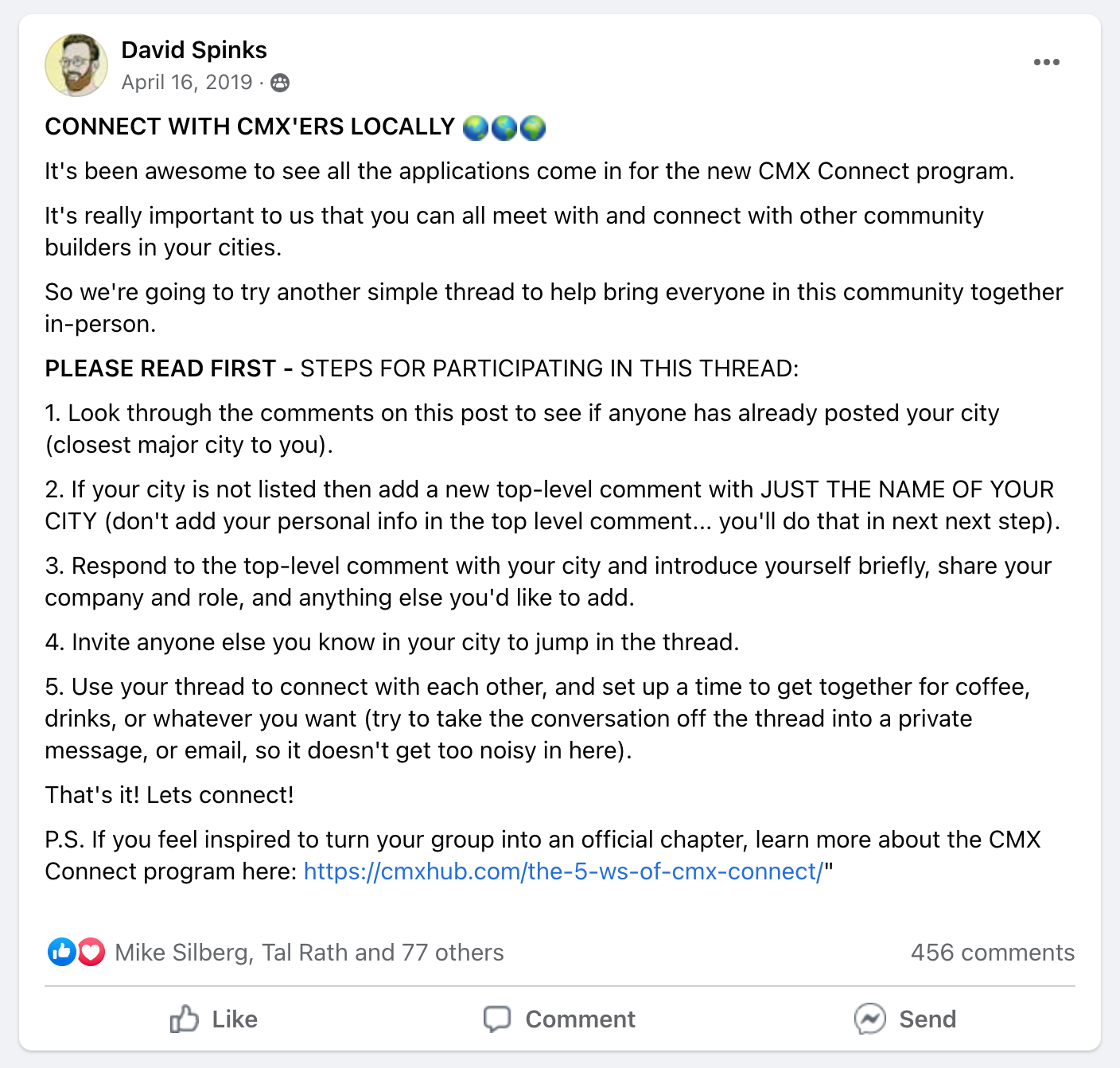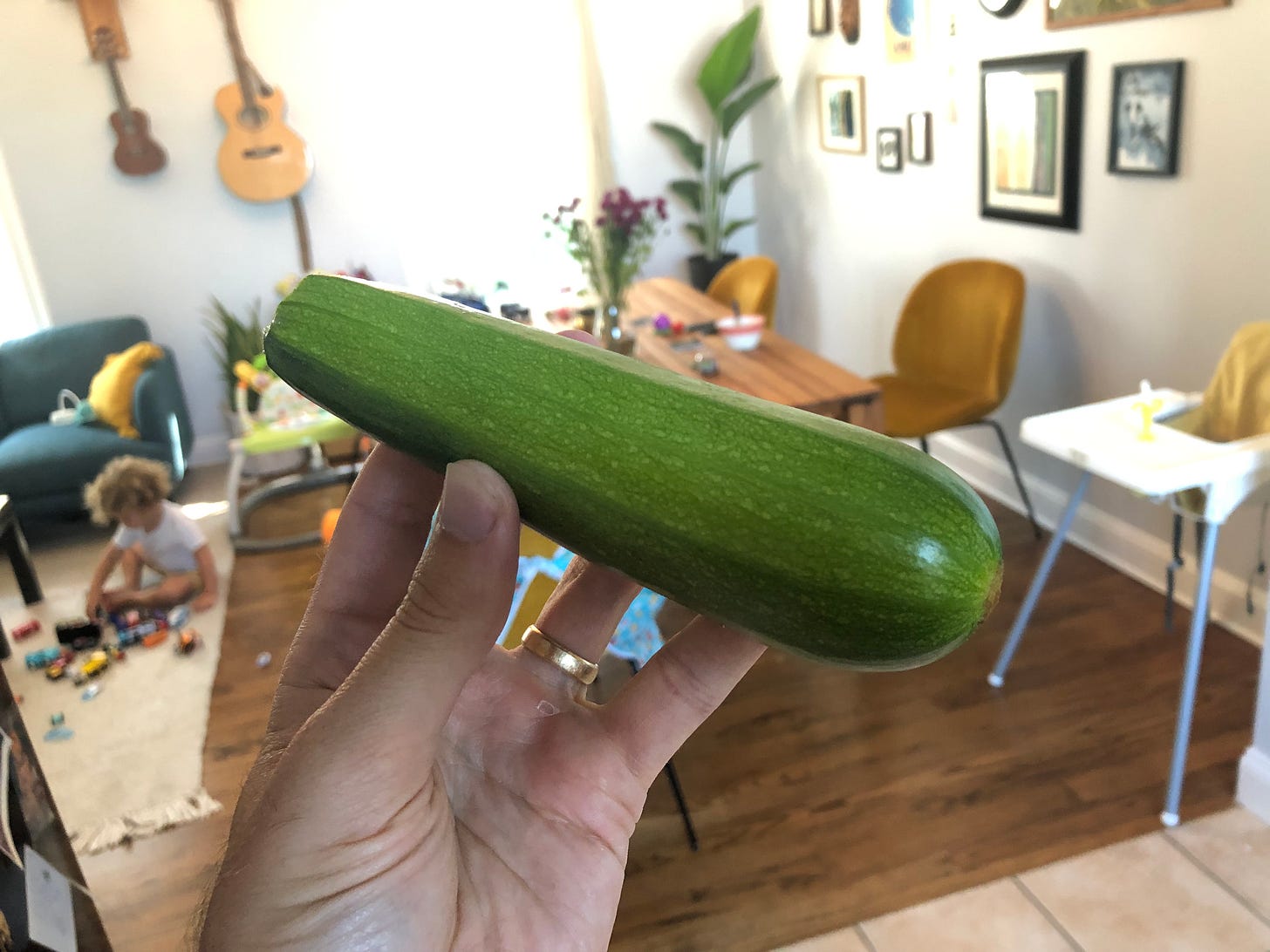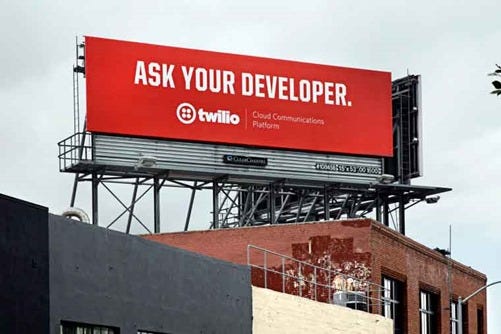Today we’re diving into one of my favorite community concepts: Engineering Serendipity.
The tension is thick:
Serendipity is the occurrence of the unplanned.
Engineering is the occurrence of the planned.
How do you plan the unplannable?
That’s what we’re exploring today.
I spent 20 hours researching and writing this one. We’re about to go deep.
IN TODAY’S EMAIL, YOU’LL LEARN:
✔️ The magic of serendipity
✔️ The serendipity process
✔️ How to create a serendipitous environment
✔️ The five levers of serendipity
THE MAGIC OF SERENDIPITY
I’ll never forget the first time I saw my wife.
It was freshman year of college. She was in front of the library, wearing a black AFI hoodie and ripped, baggy jeans covered in marker. Just my type.
My friend caught me staring and said, “That’s Alison, she’s in my math class”. I said, “Want.”
A few days later he ran into her at a frat party and shouted over the music, “Spinks has a crush on you!” She shouted back, “Who the fuck is Spinks?!” The ideal introduction.
We found each other on AIM, as one did back then (that’s AOL Instant Messenger for you youngin’s). She was “drowninginuUu” and I was “SistemOfASpYnX”. A match made in hell.
After a thorough interrogation by her roommate, I was permitted to talk to her. We scheduled an innocent “non-date” over grilled cheese at the food hall. The rest, as they say, is history.
I love telling the story of how we met because of how serendipitous it felt.
✔️ We had to go to the same college.
✔️ We had to be in front of the library at the same time.
✔️ I had to be with a friend who knew her.
✔️ That friend had to run into her at a party.
✔️ We had to have goth-y usernames. (ok not really, but it helped)
It’s this combination of seemingly random events that makes serendipity feel so special. It makes a relationship or an idea feel like it was meant to be. Like the universe made it happen.
Think about a meaningful relationship (that’s not a family member) in your life: your partner, a friend, a cofounder, etc., and reflect on how you met. Chances are, it felt serendipitous.
The more I studied serendipity the more I realized that it sits at the very essence of community.
We participate in communities with the hopes that we might find the right person, the right piece of information, the right inspiration, the right advice, at exactly the right time.
When we experience serendipity our heart rate picks up and our brain fills with dopamine. It’s intoxicating. We proclaim “WHAT ARE THE ODDS?!”
As community builders, our job is to increase those odds.
THE SERENDIPITY PROCESS
A 2015 study set out to discover how serendipity occurs.
Through in-depth interviews, they uncovered the 4-step process (edited for clarity):
⚡️ Trigger: A cue that sparks an experience of serendipity. (e.g. meet at an event, see a question in your Slack, get introduced…)
🧠 Connection: The recognition of a potential valuable outcome (e.g. learning, collaboration, friendship)
🤳 Follow-up: An action taken to obtain the valuable outcome (e.g. set up a meeting, plan a project, chat on AIM…)
🏆 Valuable outcome: The positive result of the serendipitous experience (e.g. form a meaningful relationship, learn something new, commit to build something together…)
And there’s one more factor…
For serendipity to occur, there must be an 🧵 “unexpected thread” throughout the experience. The more unexpected each step feels, the more it will be perceived as serendipity.
You can see how my experience meeting Alison followed this process:
⚡️ 1. Trigger (me seeing Alison at the library)
🧠 2. Connection (me feeling warm fuzzies)
🤳 3. Follow-up (us connecting on AIM)
🏆 4. Valuable outcome (marriage!… 13 years later)
Note: The study found that serendipity could take anywhere from weeks to years to come to fruition. Community takes time.
Now that we know the process, the next question is how can we put people in a position where serendipity is likely to occur? …
HOW TO CREATE A SERENDIPITOUS ENVIRONMENT
People are unlikely to experience serendipity unless the settings are just right.
A 2020 study found that serendipity was more likely to occur when people:
✔️ are in unfamiliar places
✔️ are with unfamiliar people
✔️ have a high willingness to socialize
✔️ aren’t too busy
✔️ have lots of energy
✔️ share common interests
✔️ have similar personalities
✔️ are comfortable in social interactions
We can sum these criteria up into three actionable categories:
🧠 Internal Context: How you prime your members. You want them to be high-energy, comfortable, not busy, and willing to socialize.
🏠 External Context: The space and format you use to bring them together. Ideally, they are unfamiliar, free of distraction, and create opportunities to meet a variety of people in a variety of contexts.
🤝 Social Context: The people you surround them with. You want people who are unfamiliar, but who have similar interests, knowledge, and personalities.
Still with me?
Good. Let’s go deeper… 🐇
THE FIVE LEVERS OF SERENDIPITY
It’s clear from the research that communities are already serendipity machines. They naturally check most of the boxes for serendipity to occur.
So, if you’re building community, you are already engineering serendipity. Mazel tov!
That said, you don’t have to leave it all to chance. Based on my research and experience, I’ve identified five levers we can use to increase the odds of serendipity…
LEVER #1: IMMERSION
Immersion means bringing members together, for an extended period of time, in a space that is free of distraction and allows them to have repeated social collisions.
One way to immerse your members is with multi-day, in-person events.
I ran large conferences for a decade and can say with confidence that they are like steroids for engineering serendipity.
Your members stay in the same hotel, spend the whole day together networking, learning, and eating, party together at after-parties, and then wake up and do it all over again.
They allow you to condense a massive amount of serendipity triggers into a couple of days.
Immersive experiences don’t have to be squeezed into a couple days though. They can take place over weeks, month, or years.
For example, last year I participated in a cohort-based course for creators, hosted by Maven. The group met online every week for an hour, for six weeks.
Students were guided to work together and give each other feedback throughout the course, creating lots of opportunities for serendipity. It was through this course that I met Jay Clouse, who I now talk to every week as we support each other in our creator journeys.
Immersive experiences check all the boxes for engineering serendipity:
✔️ are in unfamiliar places
✔️ are with unfamiliar people
✔️ have a high willingness to socialize
✔️ aren’t too busy
✔️ have lots of energy
✔️ share common interests
✔️ are comfortable in social interactions*
*Take care of your introverts by offering highly facilitated/guided experiences, and creating quiet spaces to escape (we had an “introvert zone” at CMX Summit where you weren’t allowed to talk, Evan Hamilton’s genius idea).
LEVER #2: VARIATION
The goal is to connect your members with:
a variety of unfamiliar people
a variety of unfamiliar experiences
a variety of familiar topics
To do this, you have a lot of options…
You can introduce members personally. That’s great. Or to automate introductions, you can use a tool like Donut, Meetsy, or Orbiit to match members up using AI.
You can also create a variety of connections at scale by starting threads to help your members connect around a unique subidentity. I’ve done this in the CMX community around the platforms members used to host their community:
Or based on location:
At in-person events, introduce variety by connecting members around different subtopics and identities.
For example, during lunchtime at CMX Summit, we’d host “Birds of Feather” tables where each table had a discussion topic and facilitator, so attendees could meet other people interested in the same subtopic while they ate.
We also helped members get to know each other outside of their “professional identity” by hosting experiences like group hikes, city tours, chocolate tasting, and dance parties.
I’ve been to events where instead of having attendees write just their name on their name tag, they have them write a hobby they love, a skill they have, a book they’re reading... a variety of topics to connect around.
The options are endless.
LEVER #3: FACILITATION
I planted my first garden this year.
My zucchini plant grew and grew but it wasn’t producing any damn fruit. I discovered it was because the pollinators weren’t getting to the flowers.
A quick YouTube search and I learned that you can manually pollinate the plant by rubbing the staman of the male flower in the female flower’s pistil. Steamy, I know.
And it worked! Look at this beauty:
The lesson here is that sometimes you have to help nature along.
You might assume that your members are really good at socializing.
You’ll often be wrong.
Show them how. Facilitate.
An event I recently went to sent an email out afterward with everyone’s names and contact info. We all agreed to this when we signed up so it wasn’t weird. This made it super easy to follow up, a key step in the serendipity process.
They also set up a WhatsApp chat for attendees before the event so everyone could start networking. It gave us an easy place to find each other and follow up afterward.
Sometimes it’s just about being explicit. I will ask members to make three commitments when they join our community or attend our event:
I WILL TALK TO STRANGERS (it’s why we’re all here)
I WILL NOT BE A SELF-SERVING ASSHOLE (give first)
I WILL BE PROACTIVE (it’s all about the follow-up)
Then remind them. Post in the community, or get on stage at your event, and tell them to, “Choose one person you’ve interacted with this week, who you think is rad, and invite them to coffee or a Zoom call”.
People aren’t always good at people’ing. They need permission. They need guidance.
Help them find triggers. Push them to them to follow up. They need you to facilitate.
LEVER #4: POLLINATION
Remember, serendipity is strongest when it’s most unexpected. You want your members to cross paths out there in the wild: on the train, at a concert, on a social network.
One way to make this happen:
✨ SWAG ✨
Most businesses do swag all wrong. They think their t-shirt is a billboard and that slapping their logo on it will get them that sweet brand awareness.
The way I see it, swag has two purposes:
To remind the person rocking the swag of their connection to your community
For members (and aspiring members) to recognize each other out in the wild
Heck, even the best billboards give you nothing more than a subtle wink and a nod.
It doesn’t matter what you put on the swag as long as it’s something they actually want to wear/use and it’s recognizable.
Like, I could give you all a t-shirt with a zucchini on it and, if you saw someone wearing it out in the wild, you’d know they’re a subscriber of this newsletter.
LOL ok…we might have to make this t-shirt. If 100 of you say you’ll buy it, I’ll make it.
Swag isn’t the only option for pollinating your community.
You can create badges, slogans, or titles that they can add to their bios. For example, members of the On Deck community often add ‘On Deck Fellow” or “#ODF” to their bio.
The ultimate win is just having a community so powerful that people want to talk about it wherever they go. If Jesus did it so can you.
LEVER #5: REPETITION
I recently moved back to New York after 10 years in San Francisco.
You’d think that I’d be good at making friends. It’s kind of my job. But making friends in the burbs turned out to be more difficult than I expected.
In San Francisco, I’d constantly run into the same founders over and over again on the street, at events, at coworking spaces, etc.
In the burbs, it’s taken a lot longer to make friends because I just don’t have enough of those repeat interactions with people who are similar to me.
To engineer serendipity in your community you have to create repetition. One way to do that is to offer recurring experiences.
For example, in the Trends.vc community, Dru Riley hosts daily standups where members share what they did yesterday, what they will do today, and how other members can help.
It’s this kind of repetitive action that creates countless triggers for members to connect.
To incentivize members to participate in daily standups, Dru offers access to more community resources if they maintain a daily streak:
There are lots of ways to create repetition in your community:
Monthly meetups
Weekly rituals
Office hours
Book clubs
Annual conferences
Or, most simply (but not easy): build a community so good, SO valuable, that your members WANT to come every day and spin the wheel of serendipity.
YOU ARE NOW A SERENDIPITY ENGINEER
Here’s what we covered today:
✔️ The magic of serendipity
✔️ The serendipity process
✔️ How to create a serendipitous environment
✔️ THE FIVE SERENDIPITY LEVERS:
1. Immersion
2. Variation
3. Facilitiation
4. Pollination
5. Repetition
YOUR TURN!
Serendipity is a fascinating topic. The deeper I went down the rabbit hole, the more layers I uncovered. This could be a whole book.
So let’s go deeper together:
What’s something you’ve done to engineer serendipity in your community?
Tell me about a time you’ve experienced serendipity in your life.
What other questions do you have about serendipity?
Drop a comment or hit reply.
🍭 Brain Candy
Some goodies to get your community gears turning…
🧠 Go deeper with this 10-min TED Talk on the science of serendipity.
💵 Should subscription be the default for paid communities? Why not lifetime membership?
📚 Folks who are new to community management will love this collection of resources.
🧵 Danah Boyd drops a dose of reality for Threads, and anyone else who thinks they can just copy Twitter. It’s not about the tech, it’s about the network.
📖 A reader created a practical summary of my book, for those of you who don’t feel like reading the whole thing.















Would buy the shirt:).
You know, I think my jiu jitsu school meets a lot of these criteria. I've also (anecdotally) seen a lot of serendipitous encounters, and benefited from those interactions over the years.